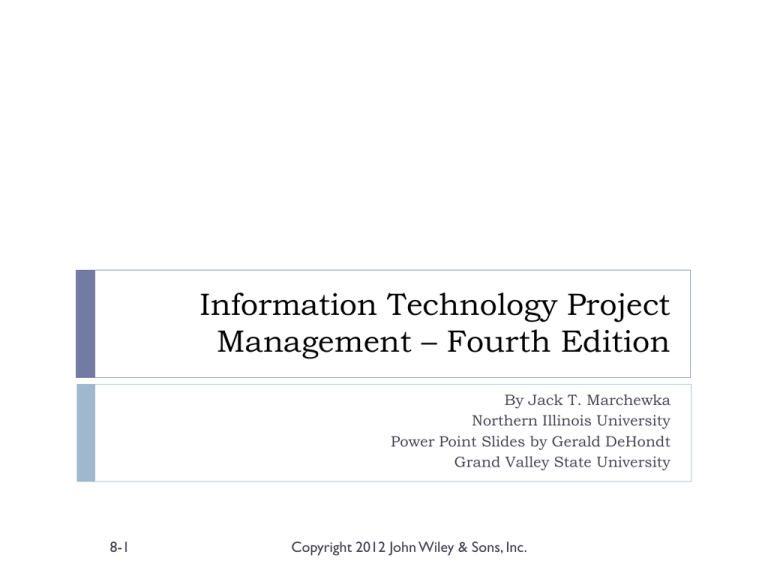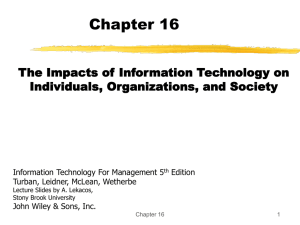
Information Technology Project
Management – Fourth Edition
By Jack T. Marchewka
Northern Illinois University
Power Point Slides by Gerald DeHondt
Grand Valley State University
8-1
Copyright 2012 John Wiley & Sons, Inc.
Managing Project Risk
Chapter 8
8-2
Copyright 2012 John Wiley & Sons, Inc.
Learning Objectives
Describe the project risk management planning framework
introduced in this chapter.
Define risk identification and the causes, effects, and integrative
nature of project risks.
Apply several qualitative and quantitative analysis techniques
that can be used to prioritize and analyze various project risks.
Describe the various risk strategies, such as insurance,
avoidance, or mitigation.
Describe risk monitoring and control.
Describe risk evaluation in terms of how the entire risk
management process should be evaluated in order to learn
from experience and to identify best practices.
8-3
Copyright 2012 John Wiley & Sons, Inc.
PMBOK® Risk Management Processes
Plan Risk Management
Identify Risks
Using a quantitative approach for developing a probabilistic model for understanding and responding to
the risks identified.
Plan Risk Responses
Focusing on a qualitative analysis concerning the impact and likelihood of the risks that were identified.
Perform Quantitative Risk Analysis
Deciding which risks can impact the project. Risk identification generally includes many of the project
stakeholders and requires an understanding of the project’s goal, as well as the project’s scope, schedule,
budget, and quality objectives.
Perform Qualitative Risk Analysis
Determining how to approach and plan the project risk management activities. An output of this
process is the development of a risk management plan.
Developing procedures and techniques to reduce the threats of risks, while enhancing the likelihood of
opportunities.
Monitor and Control Risks
8-4
Providing an early warning system to monitor identified risks and any new risks. This system ensures
that risk responses have been implemented as planned and had the effect as intended.
Copyright 2012 John Wiley & Sons, Inc.
Common Mistakes in Managing Project Risk
Not understanding the benefits of risk management
Not providing adequate time for risk management
Not identifying and assessing risk using a standardized
approach
8-5
Copyright 2012 John Wiley & Sons, Inc.
Effective & Successful Risk
Management Requires
Commitment by all stakeholders
Stakeholder responsibility
Different risks for different types of projects
8-6
Copyright 2012 John Wiley & Sons, Inc.
Definitions
Risk
An uncertain event or condition that, if occurs, has a positive
or negative effect on the project objectives.
Project Risk Management (PMBOK®)
8-7
Includes the processes of conducting risk management
planning, identification, analysis, response planning, and
monitoring and control on a project; most of these processes
are updated throughout the project. The objectives of Project
Risk Management are to increase the probability and impact of
positive events and decrease the probability and impact of
events adverse to the project.
Copyright 2012 John Wiley & Sons, Inc.
IT Project Risk Management Processes
8-8
Copyright 2012 John Wiley & Sons, Inc.
Risk Planning
Requires firm commitment by all stakeholders to a RM
approach
Assures adequate resources are in place
Focuses on preparation
8-9
Copyright 2012 John Wiley & Sons, Inc.
Risk Identification
Framework
IT Project Risk Identification Framework
8-10
Copyright 2012 John Wiley & Sons, Inc.
Risk Identification Tools & Techniques
Learning Cycles
Brainstorming
Nominal Group Technique
Delphi Technique
Interviews
Checklists
SWOT Analysis
Cause & Effect (a.k.a. Fishbone/Ishikawa)
Past Projects
8-11
Copyright 2012 John Wiley & Sons, Inc.
Nominal Group Technique (NGT)
1. Each individual silently writes their ideas on a piece of paper
2. Each idea is then written on a board or flip chart one at a time
in a round-robin fashion until each individual has listed all of his or her
ideas
3. The group then discusses and clarifies each of the ideas
4. Each individual then silently ranks and prioritizes the ideas
5. The group then discusses the rankings and priorities
6. Each individual ranks and prioritizes the ideas again
7. The rankings and prioritizations are then summarized for the group
8-12
Copyright 2012 John Wiley & Sons, Inc.
Risk Check List
Funding for the project has been secured
Funding for the project is sufficient
Funding for the project has been approved by senior management
The project team has the requisite skills to complete the project
The project has adequate manpower to complete the project
The project charter and project plan have been approved by senior
management or the project sponsor
The project’s goal is realistic and achievable
The project’s schedule is realistic and achievable
The project’s scope has been clearly defined
Processes for scope changes have been clearly defined
8-13
Copyright 2012 John Wiley & Sons, Inc.
SWOT Analysis
8-14
Copyright 2012 John Wiley & Sons, Inc.
Cause & Effect Diagram
8-15
Copyright 2012 John Wiley & Sons, Inc.
Risk Analysis & Assessment
Risk = f(Probability * Impact)
Risk assessment focuses on prioritizing risks so that
an effective strategy can be formulated for those risks
that require a response.
Depends on
Stakeholder risk
tolerances
8-16
Can’t respond to all
risks!
Copyright 2012 John Wiley & Sons, Inc.
Risk Analysis & Assessment
Qualitative Approaches
Expected Value & Payoff Tables
Decision Trees
Risk Impact Table & Ranking
Tusler’s Risk Classification
Which risks require a response?
8-17
Copyright 2012 John Wiley & Sons, Inc.
Payoff Table
A
Schedule Risk
Probability
Project completed 20 days early
5%
B
A*B
Payoff
Prob *
Payoff
(In thousands)
(In thousands)
$ 200
Project completed 10 days early
20%
$ 150
$30
Project completed on Schedule
50%
$ 100
$50
Project completed 10 days late
20%
$
Project completed 20 days late
5%
-
$ (50)
100%
8-18
$10
Copyright 2012 John Wiley & Sons, Inc.
$0
($3)
$88
The
Expected
Value
Decision Tree Analysis
8-19
Copyright 2012 John Wiley & Sons, Inc.
Risk Impact Table
0 - 100%
0-10
P*I
Probability
Impact
Score
Key project team member leaves project
40%
4
1.6
Client unable to define scope and requirements
50%
6
3.0
Client experiences financial problems
10%
9
0.9
Response time not acceptable to users/client
80%
6
4.8
Technology does not integrate with existing application
60%
7
4.2
Functional manager deflects resources away from project
20%
3
0.6
Client unable to obtain licensing agreements
5%
7
0.4
Risk (Threats)
IT Project Risk Impact Analysis
8-20
Copyright 2012 John Wiley & Sons, Inc.
Risk
Rankings
8-21
Risk (Threats)
Rankin
g
Response time not acceptable to users/client
1
Technology does not integrate with existing application
2
Client unable to define scope and requirements
3
Key project team member leaves project
4
Client experiences financial problems
5
Functional manager deflects resources away from project
6
Client unable to obtain licensing agreements
7
Copyright 2012 John Wiley & Sons, Inc.
Risk Analysis & Assessment
Quantitative Approaches
Quantitative Probability Distributions
Discrete
Continuous
8-22
Binomial
Normal
PERT
TRIANG
Copyright 2012 John Wiley & Sons, Inc.
Binomial Probability Distribution
8-23
Copyright 2012 John Wiley & Sons, Inc.
Normal Distribution
8-24
Copyright 2012 John Wiley & Sons, Inc.
Normal Distribution
Rules of thumb with respect to observations
Approximately….
68% + 1 standard deviations of mean
95% + 2 standard deviations of the mean
99% + 3 standard deviations of the mean
8-25
Copyright 2012 John Wiley & Sons, Inc.
PERT Distribution
PERT MEAN = (a + 4b + c)/6
Where:
a = optimistic estimate
b = most likely
c = pessimistic
8-26
Copyright 2012 John Wiley & Sons, Inc.
PERT Distribution
8-27
Copyright 2012 John Wiley & Sons, Inc.
Triangular Distribution
8-28
Copyright 2012 John Wiley & Sons, Inc.
Simulations
Monte Carlo
Technique that randomly generates specific values for a
variable with a specific probability distribution
Goes through a number of trials or iterations and records the
outcome
@RISK®
8-29
An MS Project® add in that provides a useful tool for conducting risk
analysis of your project plan
http://www.palisade.com/riskproject/default.asp
Copyright 2012 John Wiley & Sons, Inc.
Monte Carlo Simulation
8-30
Copyright 2012 John Wiley & Sons, Inc.
Cumulative Probability Distribution
8-31
Copyright 2012 John Wiley & Sons, Inc.
Sensitivity Analysis Using a Tornado Graph
Tornado
Graph
8-32
Copyright 2012 John Wiley & Sons, Inc.
Risk Strategies
Accept or Ignore
Management Reserves
Contingency Reserves
Part of project’s budget
Contingency Plans
Avoidance
Mitigate
Released by senior management
Reduce the likelihood or impact (or both)
Transfer
8-33
E.g. insurance
Copyright 2012 John Wiley & Sons, Inc.
Risk Strategies Depend On
The nature of the risk
Impact on MOV and project objectives
Probability? Impact?
Project constraints
Really an opportunity or threat?
Available resources?
Risk tolerances or preferences of the project
stakeholders
8-34
Copyright 2012 John Wiley & Sons, Inc.
Risk Monitoring & Control
Risk Audits
Risk Reviews
External to project team
Internal
Risk Status Meetings & Reports
8-35
Copyright 2012 John Wiley & Sons, Inc.
Risk Response Plan should include:
8-36
A trigger which flags that the risk has occurred
An owner of the risk (i.e., the person or group responsible
for monitoring the risk and ensuring that the appropriate
risk response is carried out)
A response based on one of the four basic risk strategies
Adequate resources
Copyright 2012 John Wiley & Sons, Inc.
Risk Evaluation
Lessons learned and best practices help us to:
8-37
Increase our understanding of IT project risk in general.
Understand what information was available to managing
risks and for making risk-related decisions.
Understand how and why a particular decision was made.
Understand the implications not only of the risks, but also
the decisions that were made.
Learn from our experience so that others may not have to
repeat our mistakes.
Copyright 2012 John Wiley & Sons, Inc.
Copyright 2012 John Wiley & Sons, Inc.
All rights reserved. Reproduction or translation of this work beyond that
permitted in section 117 of the 1976 United States Copyright Act without
express permission of the copyright owner is unlawful. Request for further
information should be addressed to the Permissions Department, John
Wiley & Sons, Inc. The purchaser may make back-up copies for his/her own
use only and not for distribution or resale. The Publisher assumes no
responsibility for errors, omissions, or damages caused by the use of these
programs or from the use of the information herein.
8-38
Copyright 2012 John Wiley & Sons, Inc.




